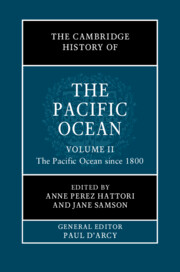Book contents
- The Cambridge History of the Pacific Ocean
- The Cambridge History of the Pacific Ocean
- The Cambridge History of the Pacific Ocean
- Copyright page
- Contents
- Figures
- Tables
- Contributors to Volume II
- Frontispiece
- General Editor’s Introduction
- Preface to Volume II
- Part VII Rethinking the Pacific
- Part VIII Approaches, Sources, and Subaltern Histories of the Modern Pacific
- Part IX Culture Contact and the Impact of Pre-colonial European Influences
- Part X The Colonial Era in the Pacific
- Part XI The Pacific Century?
- Part XII Pacific Futures
- 60 Ancestral Voices of the Sea
- 61 Defining the Contours of the Lagoon
- 62 New Pacific Voyages since Independence
- 63 Creating Sustainable Pacific Environments during the Anthropocene
- 64 Concluding Reflection
- References to Volume II
- Index
62 - New Pacific Voyages since Independence
1960 Onwards
from Part XII - Pacific Futures
Published online by Cambridge University Press: 11 November 2022
- The Cambridge History of the Pacific Ocean
- The Cambridge History of the Pacific Ocean
- The Cambridge History of the Pacific Ocean
- Copyright page
- Contents
- Figures
- Tables
- Contributors to Volume II
- Frontispiece
- General Editor’s Introduction
- Preface to Volume II
- Part VII Rethinking the Pacific
- Part VIII Approaches, Sources, and Subaltern Histories of the Modern Pacific
- Part IX Culture Contact and the Impact of Pre-colonial European Influences
- Part X The Colonial Era in the Pacific
- Part XI The Pacific Century?
- Part XII Pacific Futures
- 60 Ancestral Voices of the Sea
- 61 Defining the Contours of the Lagoon
- 62 New Pacific Voyages since Independence
- 63 Creating Sustainable Pacific Environments during the Anthropocene
- 64 Concluding Reflection
- References to Volume II
- Index
Summary
In this chapter we discuss new contemporary voyages Pacific people have embarked upon since the independence period of the 1960s. In doing so we adopt Epeli Hau‘ofa’s view of contemporary Pacific migration and transnationalism as a process of world enlargement. Pacific migration has often been viewed in limited terms such as outward migration and one-directional flows. The migration patterns and experiences of the region are varied and complex, and current economic theories of migration are inadequate in capturing the nuances of the Pacific region and fail to recognize migration, mobility, and movement as a social and cultural act and not merely economically motivated; they are culturally specific, grounded in social ontologies and historical encounters. In this chapter we argue for a transnational approach in thinking about and understanding Pacific contemporary migration since the 1960s. Pacific migration, mobility, and movement is not simply about individuals themselves but rather about complex networks and flows of people, families, organizations, ideas, and goods, creating communities that expand across multiple nation-states. The chapter begins with a discussion on what is Pacific transnational flow and how this differs to dominate discourses on international migration and movement. We then describe different types of flows beginning with where people have moved to and explore the main drivers of migration: money and remittances. We then outline the different types of migration and mobility pathways that Pacific people have undertaken since the 1960s, with a particular focus on educational opportunities and employment opportunities such as seasonal labour migration schemes and sports migration. We conclude the chapter by considering the impact of climate change and migration for future generations of Pacific people.
- Type
- Chapter
- Information
- The Cambridge History of the Pacific Ocean , pp. 752 - 775Publisher: Cambridge University PressPrint publication year: 2023

